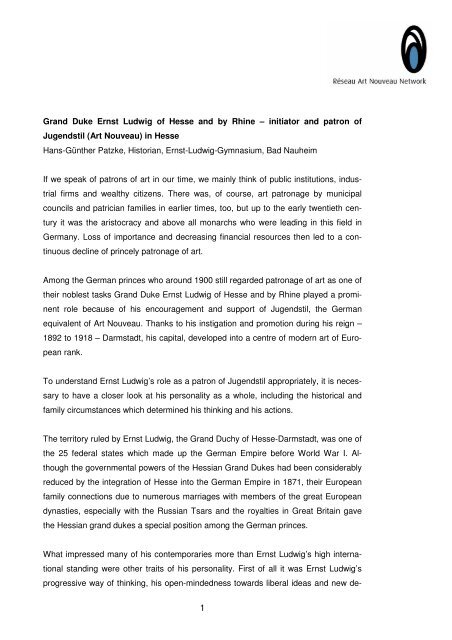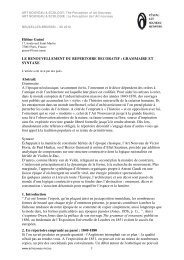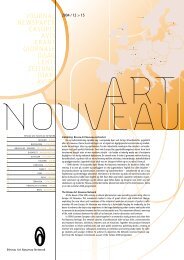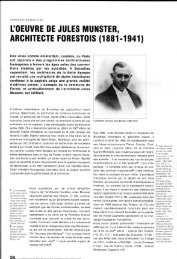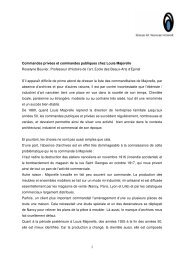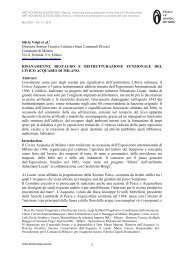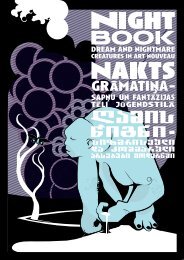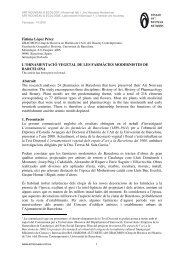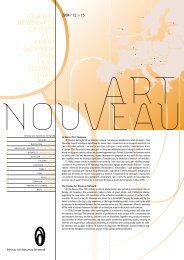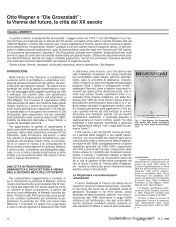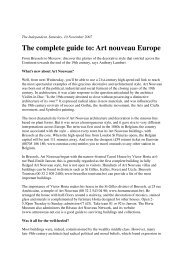Grand Duke Ernst Ludwig of Hesse and by Rhine - Art Nouveau ...
Grand Duke Ernst Ludwig of Hesse and by Rhine - Art Nouveau ...
Grand Duke Ernst Ludwig of Hesse and by Rhine - Art Nouveau ...
Create successful ePaper yourself
Turn your PDF publications into a flip-book with our unique Google optimized e-Paper software.
<strong>Gr<strong>and</strong></strong> <strong>Duke</strong> <strong>Ernst</strong> <strong>Ludwig</strong> <strong>of</strong> <strong>Hesse</strong> <strong>and</strong> <strong>by</strong> <strong>Rhine</strong> – initiator <strong>and</strong> patron <strong>of</strong><br />
Jugendstil (<strong>Art</strong> <strong>Nouveau</strong>) in <strong>Hesse</strong><br />
Hans-Günther Patzke, Historian, <strong>Ernst</strong>-<strong>Ludwig</strong>-Gymnasium, Bad Nauheim<br />
If we speak <strong>of</strong> patrons <strong>of</strong> art in our time, we mainly think <strong>of</strong> public institutions, indus-<br />
trial firms <strong>and</strong> wealthy citizens. There was, <strong>of</strong> course, art patronage <strong>by</strong> municipal<br />
councils <strong>and</strong> patrician families in earlier times, too, but up to the early twentieth cen-<br />
tury it was the aristocracy <strong>and</strong> above all monarchs who were leading in this field in<br />
Germany. Loss <strong>of</strong> importance <strong>and</strong> decreasing financial resources then led to a con-<br />
tinuous decline <strong>of</strong> princely patronage <strong>of</strong> art.<br />
Among the German princes who around 1900 still regarded patronage <strong>of</strong> art as one <strong>of</strong><br />
their noblest tasks <strong>Gr<strong>and</strong></strong> <strong>Duke</strong> <strong>Ernst</strong> <strong>Ludwig</strong> <strong>of</strong> <strong>Hesse</strong> <strong>and</strong> <strong>by</strong> <strong>Rhine</strong> played a promi-<br />
nent role because <strong>of</strong> his encouragement <strong>and</strong> support <strong>of</strong> Jugendstil, the German<br />
equivalent <strong>of</strong> <strong>Art</strong> <strong>Nouveau</strong>. Thanks to his instigation <strong>and</strong> promotion during his reign –<br />
1892 to 1918 – Darmstadt, his capital, developed into a centre <strong>of</strong> modern art <strong>of</strong> Euro-<br />
pean rank.<br />
To underst<strong>and</strong> <strong>Ernst</strong> <strong>Ludwig</strong>’s role as a patron <strong>of</strong> Jugendstil appropriately, it is neces-<br />
sary to have a closer look at his personality as a whole, including the historical <strong>and</strong><br />
family circumstances which determined his thinking <strong>and</strong> his actions.<br />
The territory ruled <strong>by</strong> <strong>Ernst</strong> <strong>Ludwig</strong>, the <strong>Gr<strong>and</strong></strong> Duchy <strong>of</strong> <strong>Hesse</strong>-Darmstadt, was one <strong>of</strong><br />
the 25 federal states which made up the German Empire before World War I. Al-<br />
though the governmental powers <strong>of</strong> the Hessian <strong>Gr<strong>and</strong></strong> <strong>Duke</strong>s had been considerably<br />
reduced <strong>by</strong> the integration <strong>of</strong> <strong>Hesse</strong> into the German Empire in 1871, their European<br />
family connections due to numerous marriages with members <strong>of</strong> the great European<br />
dynasties, especially with the Russian Tsars <strong>and</strong> the royalties in Great Britain gave<br />
the Hessian gr<strong>and</strong> dukes a special position among the German princes.<br />
What impressed many <strong>of</strong> his contemporaries more than <strong>Ernst</strong> <strong>Ludwig</strong>’s high interna-<br />
tional st<strong>and</strong>ing were other traits <strong>of</strong> his personality. First <strong>of</strong> all it was <strong>Ernst</strong> <strong>Ludwig</strong>’s<br />
progressive way <strong>of</strong> thinking, his open-mindedness towards liberal ideas <strong>and</strong> new de-<br />
1
velopments in different fields <strong>of</strong> life, attitudes which made him popular among those<br />
who were dissatisfied with the conservative trends dominating social <strong>and</strong> political life<br />
in Germany before World War I. Statements <strong>of</strong> competent authorities prove how posi-<br />
tively <strong>Ernst</strong> <strong>Ludwig</strong> was judged. So Pr<strong>of</strong>. Dr. Theodor Heuss, President <strong>of</strong> the young<br />
Federal Republic <strong>of</strong> Germany in the fifties, stated: “To us, when we were young, the<br />
20 th century – as a promise <strong>and</strong> task – actually began in Darmstadt. For our youthful<br />
consciousness <strong>Hesse</strong>’s last <strong>Gr<strong>and</strong></strong> <strong>Duke</strong> <strong>Ernst</strong> <strong>Ludwig</strong> was the spiritually <strong>and</strong> intellec-<br />
tually most important personality among the German monarchs in his time. The Hes-<br />
sian <strong>Gr<strong>and</strong></strong> <strong>Duke</strong> was obviously in his way <strong>of</strong> thinking what we call an avant-gardist.”<br />
The high esteem, as it is expressed here, was justified <strong>by</strong> how <strong>Ernst</strong> <strong>Ludwig</strong> practised<br />
<strong>and</strong> looked at his tasks as a reigning prince. His thoughts are laid down in a series <strong>of</strong><br />
notes like his memoirs <strong>and</strong> the “Fundamental ideas <strong>of</strong> a constitutional prince”. <strong>Ernst</strong><br />
<strong>Ludwig</strong> no longer believed in an inherited divine right <strong>of</strong> monarchs. In his opinion a<br />
reigning prince every day had to prove his abilities to reign his country just as anybody<br />
else had to justify his social position <strong>by</strong> personal achievements.<br />
<strong>Ernst</strong> <strong>Ludwig</strong> recognized that he lived on the threshold <strong>of</strong> a new era involving rapid<br />
technical changes. “If we don’t keep pace with these changes” – so his words – “we<br />
will be passed over or disregarded as outdated”. The uppermost duties <strong>of</strong> a reigning<br />
prince were – to him - to see to the improvement <strong>of</strong> the conditions <strong>of</strong> life in his country<br />
<strong>and</strong> to motivate people to accept innovations. Promising new possibilities he saw in<br />
the sphere <strong>of</strong> electricity <strong>and</strong> in the development <strong>of</strong> the motor-car. In this respect he<br />
cultivated a close relationship with the owners <strong>of</strong> the Opel factory in Rüsselsheim, <strong>and</strong><br />
it was him who persuaded them to take up the production <strong>of</strong> motor-cars at a time<br />
when this new invention was still regarded with scepticism. He was a passionate<br />
driver <strong>of</strong> Opel cars, <strong>and</strong> the firm’s most successful propag<strong>and</strong>ist. Besides he sup-<br />
ported the health care measures <strong>and</strong> the charitable work <strong>of</strong> his wife who continued his<br />
mother Alice’s activities in this sphere.<br />
He <strong>of</strong>ten criticized his princely colleagues for their antiquated way <strong>of</strong> thinking. “When I<br />
stayed in Berlin on the occasion <strong>of</strong> the Kaiser‘s birthday”, we read in his memoirs, ”I<br />
realized that many <strong>of</strong> my colleagues were so backward in their views that I felt like a<br />
socialist”. He surely did not use the word “ socialist” contemptuously. Unlike his<br />
cousin, the Kaiser, who blamed social democrats as “unpatriotic fellows”, <strong>Ernst</strong><br />
<strong>Ludwig</strong> dealt with politicians <strong>of</strong> that party in a respectful way. No wonder that in con-<br />
servative circles he was denounced as “a revolutionary prince”, “the red <strong>Gr<strong>and</strong></strong> <strong>Duke</strong>”.<br />
2
<strong>Ernst</strong> <strong>Ludwig</strong> had grown up in a family strongly attached to arts <strong>and</strong> music. It was<br />
mainly his mother Alice, daughter <strong>of</strong> Queen Victoria <strong>of</strong> Great Britain, to whom he<br />
owed his social sensitivity <strong>and</strong> above all his artistic inclinations, <strong>and</strong> whose education<br />
<strong>and</strong> example shaped his philosophy <strong>of</strong> life. Important for his progressive <strong>and</strong> liberal<br />
ideas, for the broadening <strong>of</strong> his horizon were his international contacts especially with<br />
Engl<strong>and</strong>. After his mother’s early death, it was Queen Victoria <strong>of</strong> Great Britain who<br />
took him under her wing. Among her 40 gr<strong>and</strong>children <strong>Ernst</strong> <strong>Ludwig</strong> is said to have<br />
been her favourite gr<strong>and</strong>son. The old lady came to Darmstadt every two or three<br />
years. Still more frequently <strong>Ernst</strong> <strong>Ludwig</strong> visited Engl<strong>and</strong>, which was something like a<br />
second homel<strong>and</strong> to him. To Golo Mann <strong>Ernst</strong> <strong>Ludwig</strong> was a combination <strong>of</strong> an Eng-<br />
lish-European gentleman <strong>and</strong> a German patriot, without nationalistic implications.<br />
There was a logical connection between his progressive thinking <strong>and</strong> his extraordinary<br />
commitment to modern arts. As already mentioned, the integration <strong>of</strong> the <strong>Gr<strong>and</strong></strong><br />
Duchy <strong>of</strong> <strong>Hesse</strong>-Darmstadt into the German Empire had left little political power to the<br />
gr<strong>and</strong> dukes. Most <strong>of</strong> the laws <strong>and</strong> administrative regulations practised in the gr<strong>and</strong><br />
duchy were made in Berlin. This allowed <strong>Ernst</strong> <strong>Ludwig</strong> to devote himself extensively to<br />
the cultural <strong>and</strong> economic development <strong>of</strong> his country <strong>and</strong> the patronage <strong>of</strong> modern<br />
arts. “My <strong>Hesse</strong>n may flourish, <strong>and</strong> in it the arts” was his motto, <strong>and</strong> he unwaveringly<br />
stuck to it in spite <strong>of</strong> the fact that the financial means the <strong>Gr<strong>and</strong></strong> <strong>Duke</strong> had at his dis-<br />
posal were limited compared to what rich towns like Frankfurt, München, Berlin, Dres-<br />
den could spend on art.<br />
From the very beginning <strong>of</strong> his reign in 1892, <strong>Ernst</strong> <strong>Ludwig</strong> left no doubt that he in-<br />
tended to have an essential say in matters <strong>of</strong> arts <strong>and</strong> good taste. So he at once re-<br />
jected the plans for the new state museum in Darmstadt as ugly <strong>and</strong> an eyesore to<br />
Darmstadt, <strong>and</strong> had them altered <strong>by</strong> a young architect <strong>of</strong> his own choice (Alfred Mes-<br />
sel). Only a few years later – in 1897 - he for the first time openly manifested his pref-<br />
erence for Jugendstil when he had part <strong>of</strong> his Neues Palais decorated <strong>and</strong> furnished<br />
in modern style. What fascinated him about the Jugendstil movement was above all<br />
the idea <strong>of</strong> a reform <strong>of</strong> life under the influence <strong>of</strong> the arts.<br />
<strong>Ernst</strong> <strong>Ludwig</strong>’s reputation as a patron <strong>of</strong> modern art is especially connected with the<br />
KÜNSTLERKOLONIE, i.e. the artists’ colony, which he founded on the Mathildenhöhe<br />
in the park area around the Russian Chapel in Darmstadt in 1899. He invited archi-<br />
tects, sculptors, ceramicists <strong>and</strong> graphic artists to join the artists’ community which<br />
3
should give them the opportunity to realize their individual ideas. Between 1899 <strong>and</strong><br />
1914 twenty-three artists worked together on the Mathildenhöhe for a shorter or<br />
longer time, among them such renowned personalities as Peter Behrens, Hans<br />
Christiansen, <strong>and</strong> Joseph Maria Olbrich. It was Olbrich in whom the <strong>Gr<strong>and</strong></strong> <strong>Duke</strong><br />
found a like-minded, congenial partner <strong>and</strong> who till his sudden death in 1908 was in<br />
some respect the head <strong>of</strong> the artists’ colony.<br />
What distinguished the Darmstadt artists’ colony from other artists’ colonies was that<br />
<strong>by</strong> creating new forms <strong>of</strong> architecture <strong>and</strong> decorative design – on the premise <strong>of</strong><br />
Jugendstil - it should be a driving force for the development <strong>of</strong> the country’s crafts,<br />
<strong>and</strong> so also be <strong>of</strong> benefit to the industrial progress <strong>of</strong> <strong>Hesse</strong>. As the <strong>Gr<strong>and</strong></strong> <strong>Duke</strong> re-<br />
jected the hierarchical distinction between high arts <strong>and</strong> applied arts, he wanted the<br />
artists to give practical impulses to the crafts to take up innovative ideas. That did not<br />
mean that they should imitate Jugendstil designs <strong>of</strong> the Mathildenhöhe slavishly. The<br />
<strong>Gr<strong>and</strong></strong> <strong>Duke</strong> rather expected this kind <strong>of</strong> relation to help to bring about an autonomous<br />
Darmstadt Jugendstil.<br />
<strong>Ernst</strong> <strong>Ludwig</strong>’s role in the artists’ colony was not that <strong>of</strong> a passive observer. He ac-<br />
companied the artists’ work with his advice <strong>and</strong> proposals <strong>and</strong> discussed many <strong>of</strong><br />
their plans with them. The artists obviously did not feel his suggestions as orders.<br />
<strong>Ernst</strong> <strong>Ludwig</strong> described this cooperation as a wonderful time. “Being young myself, I<br />
could underst<strong>and</strong> the sometimes highflying ideas <strong>of</strong> those young men. They were <strong>of</strong>-<br />
ten confronted with opposition, <strong>and</strong> I could help them to overcome narrow-minded<br />
intrigues”.<br />
Highlights <strong>of</strong> the artists’ colony were four exhibitions between 1901 <strong>and</strong> 1914, at<br />
which the artists could present the results <strong>of</strong> their work to a broader public. In 1901, it<br />
was the <strong>Ernst</strong>-<strong>Ludwig</strong>-House, the artists’ common atelier house, <strong>and</strong> the dwelling<br />
houses <strong>of</strong> the artists with their Jugendstil furnishings which were the main objects <strong>of</strong><br />
interest. They were meant as model houses showing how architecture, interior design,<br />
applied art <strong>and</strong> painting could be brought together as Gesamtkunstwerke, <strong>and</strong> so<br />
make a new form <strong>of</strong> cultivated living possible. The <strong>Gr<strong>and</strong></strong> <strong>Duke</strong> commented that it was<br />
fascinating to see how much comfort <strong>and</strong> grace could be attained if art <strong>and</strong> good taste<br />
showed the way”.<br />
Among Olbrich’s probably best achievements after the first exhibition are reckoned<br />
works created at the personal request <strong>of</strong> the <strong>Gr<strong>and</strong></strong> <strong>Duke</strong>, especially – in 1902 - the<br />
4
playhouse in the park <strong>of</strong> Wolfsgarten for <strong>Ernst</strong> <strong>Ludwig</strong>’s little daughter Elisabeth, the<br />
only child from his first – unhappy – marriage with Mellita <strong>of</strong> Saxe-Coburg. The little<br />
princess’s death only a year later was a serious stroke to the <strong>Gr<strong>and</strong></strong> <strong>Duke</strong>.<br />
The following exhibitions showed the gradual development <strong>of</strong> several artists away<br />
from the revolutionary, eccentric forms <strong>of</strong> early Jugendstil to more moderate, maturer<br />
forms with approaches to a new classicism, a development that can be noticed at the<br />
Jugendstil buildings in Bad Nauheim as well. Besides the artists tried to react to the<br />
criticism <strong>of</strong> the elitist luxury in which the artists’ houses <strong>of</strong> the exhibition in 1901 were<br />
furnished. So a workers’ village was to show that even cheap houses did not need to<br />
do without artistic embellishments. What aroused special admiration at the third, the<br />
“<strong>Hesse</strong> State Exhibition for Free <strong>and</strong> Applied <strong>Art</strong>”, in 1908 was a large new exhibition<br />
building <strong>and</strong> the wedding tower designed <strong>by</strong> Joseph Maria Olbrich as Darmstadt’s<br />
present to <strong>Ernst</strong> <strong>Ludwig</strong> <strong>and</strong> his second wife Eleonore <strong>of</strong> Solms-Hohensolms-Lich on<br />
the occasion <strong>of</strong> their wedding.<br />
That the <strong>Gr<strong>and</strong></strong> <strong>Duke</strong>’s idea <strong>of</strong> a close collaboration between arts <strong>and</strong> crafts was no<br />
utopian dream, was for the first time manifested <strong>by</strong> the so-called “Darmstadt Room”,<br />
designed <strong>by</strong> Olbrich, produced <strong>by</strong> the furniture factory Glückert, <strong>and</strong> exhibited at the<br />
World Exhibition in Paris in 1900. In the following years, more producing firms (furni-<br />
ture, pianos, textiles etc.) modelled their products on designs <strong>of</strong> the artists’ colony,<br />
<strong>and</strong> the <strong>Gr<strong>and</strong></strong> <strong>Duke</strong> tried to foster the collaboration <strong>by</strong> founding enterprises <strong>of</strong> his<br />
own like the “<strong>Gr<strong>and</strong></strong> Ducal Ceramic Manufactory” under the direction <strong>of</strong> Jakob Julius<br />
Scharvogel.<br />
Outside Darmstadt it was mainly Bad Nauheim that pr<strong>of</strong>ited from <strong>Ernst</strong> <strong>Ludwig</strong>’s far-<br />
sighted way <strong>of</strong> thinking <strong>and</strong> his artistic ambitions. From Celtic times the area <strong>of</strong> Nau-<br />
heim had been a place where salt water springs allowed pr<strong>of</strong>itable salt production.<br />
After the curative powers <strong>of</strong> salt water baths had been rediscovered, Nauheim be-<br />
came an internationally renowned health resort, mainly for heart <strong>and</strong> circulatory com-<br />
plaints with a growing popularity in aristocratic <strong>and</strong> bourgeois well-to-do circles. But<br />
around 1900 the conditions <strong>of</strong> the spa facilities no longer came up to the dem<strong>and</strong>s <strong>of</strong><br />
the spa guests: the few bathhouses could not cope with the growing number <strong>of</strong> pa-<br />
tients, the houses were scattered over a wide area, their equipment was outmoded.<br />
<strong>Ernst</strong> <strong>Ludwig</strong> recognized the danger that more <strong>and</strong> more <strong>of</strong> the well-paying guests<br />
would move to better equipped spas if the facilities in Bad Nauheim were not enlarged<br />
<strong>and</strong> modernized. “For a long time”, he said in his memoirs, ”I have felt that the gov-<br />
5
ernment hasn’t done enough for Bad Nauheim. I had to struggle hard with the gov-<br />
ernment because I could not convince the ministers that you must invest a lot in an<br />
enterprise before you can hope that it will yield pr<strong>of</strong>it.”<br />
The planning <strong>of</strong> the building works was entrusted to an ingenious young architect,<br />
Wilhelm Jost. His concept was to pull down everything that was outmoded <strong>and</strong> to re-<br />
place it with an extended complex <strong>of</strong> new buildings technically <strong>and</strong> aesthetically mod-<br />
ern. Jost was no friend <strong>of</strong> radical modernism, but nevertheless open to quite a lot <strong>of</strong><br />
aspects <strong>of</strong> Jugendstil. He claimed that modern building should be a synthesis <strong>of</strong> ap-<br />
proved traditional forms <strong>and</strong> elements <strong>of</strong> modern design, <strong>and</strong> so he was near <strong>Ernst</strong><br />
<strong>Ludwig</strong>’s expectations who favoured stylistic concepts that tried to harmonize new<br />
influences with traditional forms <strong>of</strong> art, to “incorporate the good <strong>of</strong> the past into the<br />
aspirations <strong>of</strong> the future”.<br />
How such a concept could materialize can be seen <strong>by</strong> Jost’s main project in Bad<br />
Nauheim, the Sprudelh<strong>of</strong>, fountain courtyard (1905 – 1911). With its symmetrical lay-<br />
out <strong>and</strong> its neo-baroque architecture it rather reminds <strong>of</strong> an 18 th century palace than <strong>of</strong><br />
a Jugendstil building. But the architecture is superimposed <strong>by</strong> quite a lot <strong>of</strong> Jugendstil<br />
elements like the curving ro<strong>of</strong>s, the wave <strong>and</strong> water bubble patterns, the portal frames<br />
<strong>and</strong> the stained glass windows.<br />
Visitors who enter the houses behind the long arcades <strong>and</strong> cast more than a short<br />
glance at the interior cannot be but fascinated <strong>by</strong> the way in which - in contrast to the<br />
outside - Jugendstil design dominates in the waiting halls as well as in the inner deco-<br />
rative courtyards <strong>and</strong> in the bath cubicles. It was due to the <strong>Gr<strong>and</strong></strong> <strong>Duke</strong>’s initiative<br />
that also members <strong>of</strong> the artists’ colony in Darmstadt were commissioned to contrib-<br />
ute to the ornamental decoration <strong>and</strong> the furnishing <strong>of</strong> the interiors <strong>of</strong> the bathhouses.<br />
The collaboration between Jost <strong>and</strong> artists like the sculptor Heinrich Jobst, the ce-<br />
ramic designer Jacob Julius Scharvogel <strong>and</strong> others brought about masterpieces <strong>of</strong><br />
Jugendstil. The results can be mainly admired in Bathhouse 7, whose interior – with<br />
Scharvogel’s ceramic works - was displayed at the Hessian State Exhibition <strong>of</strong> 1908.<br />
<strong>Art</strong> historians judge that the creation <strong>of</strong> the Sprudelh<strong>of</strong> in Bad Nauheim is perhaps the<br />
most convincing example <strong>of</strong> how <strong>Gr<strong>and</strong></strong> <strong>Duke</strong> <strong>Ernst</strong> <strong>Ludwig</strong>’s patronage raised the<br />
quality <strong>of</strong> applied art. At the same time the Jugendstil buildings in Bad Nauheim are a<br />
successful realization <strong>of</strong> <strong>Ernst</strong> <strong>Ludwig</strong>’s ideal <strong>of</strong> combining the beautiful with the prac-<br />
tically useful.<br />
6
<strong>Ernst</strong> <strong>Ludwig</strong> followed the construction works in Bad Nauheim with the discerning eye<br />
<strong>of</strong> an expert. It was with the Trinkkuranlage, pump room complex, - 1910 –1911 - that<br />
<strong>Ernst</strong> <strong>Ludwig</strong> partly interfered in the planning, but Jost stated later that like Olbrich he<br />
had pr<strong>of</strong>ited from the <strong>Gr<strong>and</strong></strong> <strong>Duke</strong>’s architectural suggestions. They helped him to<br />
create what was later regarded as a harmonious unit: cure spring temple – milk-<br />
drinking hall opposite each other, <strong>and</strong> the music pavilion with a water basin in be-<br />
tween.<br />
<strong>Ernst</strong> <strong>Ludwig</strong> proved his personal interest in Bad Nauheim <strong>by</strong> frequent visits to the<br />
town, not only to see relatives taking the waters there like Empress Elisabeth <strong>of</strong> Aus-<br />
tria in 1898, <strong>and</strong> Tsar Nikolaus II <strong>and</strong> Tsarina Alex<strong>and</strong>ra <strong>of</strong> Russia, <strong>Ernst</strong> <strong>Ludwig</strong>’s<br />
sister, in 1910, but also in order to inspect the progress <strong>of</strong> building. He came over<br />
from his castle in Friedberg, sometimes – as the local press reports - <strong>by</strong> bike, moving<br />
about incognito.<br />
Bad Nauheim’s development into a Jugendstil spa would not have been possible<br />
without the initiative <strong>of</strong> <strong>Gr<strong>and</strong></strong> <strong>Duke</strong> <strong>Ernst</strong> <strong>Ludwig</strong>. The buildings which were erected in<br />
the spa town between 1901 <strong>and</strong> 1911 ( there were several other projects realized at<br />
the suggestion <strong>of</strong> <strong>Ernst</strong> <strong>Ludwig</strong>, besides the fountain court <strong>and</strong> the pump room com-<br />
plex ) considerably mark the townscape still today. The names <strong>of</strong> an avenue, <strong>of</strong> a min-<br />
eral spring <strong>and</strong> <strong>of</strong> Bad Nauheim’s grammar school <strong>of</strong> 1905 still remind <strong>of</strong> the spa<br />
town’s greatest benefactor.<br />
<strong>Ernst</strong> <strong>Ludwig</strong> not only fostered the arts <strong>of</strong> his time. Under his influence <strong>Hesse</strong> as the<br />
first German state got a Denkmalschutzgesetz securing the conservation <strong>and</strong> restora-<br />
tion <strong>of</strong> historical buildings.<br />
After all that it must not be ignored that <strong>Ernst</strong> <strong>Ludwig</strong> proved his artistic talents in more<br />
than what had been described so far. He painted, wrote poems in German <strong>and</strong> Eng-<br />
lish, composed pieces <strong>of</strong> music <strong>and</strong> especially did a lot in the field <strong>of</strong> theatrical pro-<br />
ductions. He designed properties <strong>and</strong> costumes for theatre performances <strong>and</strong> influ-<br />
enced the stagings at the Darmstadt Opera House.<br />
<strong>Ernst</strong> <strong>Ludwig</strong>’s dethronement in the wake <strong>of</strong> the November Revolution <strong>of</strong> 1918 did not<br />
in the least diminish his popularity in <strong>Hesse</strong>, but it meant the end <strong>of</strong> the artists’ colony<br />
<strong>and</strong> its exhibitions, as the greatest part <strong>of</strong> the money for the colony had been paid<br />
from the <strong>Gr<strong>and</strong></strong> <strong>Duke</strong>’s budget. In the following decades the recognition <strong>of</strong> the results<br />
7
<strong>of</strong> <strong>Ernst</strong> <strong>Ludwig</strong>‘s initiatives especially in connection with the artists’ colony suffered<br />
from the widespread decline <strong>of</strong> interest in Jugendstil. It is mainly due to the activities<br />
<strong>of</strong> art historians, institutions <strong>and</strong> Jugendstil associations that today the achievements<br />
<strong>of</strong> <strong>Ernst</strong> <strong>Ludwig</strong> <strong>and</strong> the artists supported <strong>by</strong> him again get the appreciation <strong>and</strong> admi-<br />
ration they deserve.<br />
<strong>Ernst</strong> <strong>Ludwig</strong> died on October 9 th , 1937 in Wolfsgarten near Darmstadt - about a<br />
month before a tragic fate befell his family: his wife Eleonore, their eldest son <strong>and</strong> his<br />
wife, sister <strong>of</strong> the present <strong>Duke</strong> <strong>of</strong> Edinburgh, <strong>and</strong> their two young sons perished in a<br />
plane crash near Oostende on November 16 th , 1937.<br />
8


